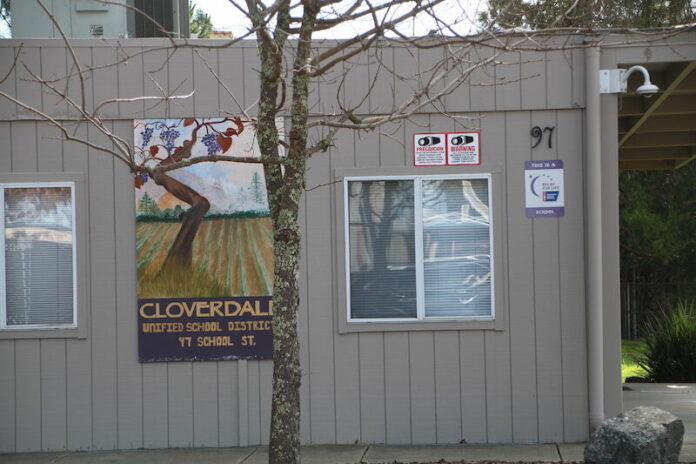Cost of testing, unclear guidelines are barriers to reopening sooner
Due to a handful of barriers, the Cloverdale Unified School District (CUSD) isn’t currently trying to seek special permission to reopen to K-6 students while the county remains in the purple COVID-19 tier.
In a joint statement last week, the county of Sonoma and the Sonoma County Office of Education (SCOE) announced that Sonoma County reached an adjusted daily virus case rate of less than 25 cases per 100,000 people for five consecutive days — which, per recent state guidance under California’s Safe Schools for All Plan, means that districts can submit their COVID-19 Safety Plan (CSP) to state and local health officials for review and approval to reopen for in-person instructions.
While the county is still in the purple tier, schools serving any grade level will be able to reopen once the county moves to the red tier for five consecutive days. In order to move to the red tier, county case rates must be below 7 per 100,000 people. As of Feb. 16, Sonoma County’s case rate per 100,000 people was 14.2.
For Cloverdale, the ability to submit plans for reopening K-6 doesn’t mean that the district feels equipped to do so.
Among the reasons the district isn’t rushing to reopen is the cost associated with virus testing (which is required for districts that reopen before their county is in the red tier), a lack of guidance regarding what needs to be included in district site plans and resistance from school staff to return before they’re able to be vaccinated.
CUSD Superintendent Betha MacClain said that the district will likely start with a progressive reopening once Sonoma County gets placed into the red tier, with elementary students heading back first, followed by the secondary schools.
MacClain will be presenting a suggested timeline and other associated information to the district’s board of trustees during the regular board meeting on Feb. 17.
Why wait until the red tier to open? Doing so eliminates some of the barriers that the district is struggling with.
“The real issue — I would say the biggest barrier — is that if you open in purple, you have this testing cadence,” MacClain said in an interview on Feb. 11, noting that the state has said it might reimburse districts for the costly COVID-19 testing process, but that the money isn’t guaranteed and the process to chase the reimbursement can be costly in and of itself.
The cost of providing regular testing to district employees would exceed $30,000 per month, allotting for 1,000 tests to be administered, MacClain said, and doesn’t include the cost associated with any part-time employee the district might have to hire to try and seek payment from insurance companies or follow-up on possible state reimbursements.
“The labor and chasing down the payments, none of that is being done by the state, it’s going to be done by individual sites. We’re not Kaiser who’s constantly interacting with people’s benefits companies. It’s a crazy proposition for a school, especially a (small one),” she said.
While the CUSD is looking to push back reopening until the county’s virus numbers dip into the red tier, it has opened its doors to some small cohorts, which required a different slew of paperwork and preparation but pushed Cloverdale farther into reopening territory than its northern Sonoma County neighbors.
The addition of another plan in the form of the CSP means that it needs to spend time working its reopening information into another new kind of document.
“As far as I’m concerned, we’ve been pushing hard. But some of the things that we’ve had to do to open small cohorts — there’s the site-specific protection plan that the county required — now there’s a different site-specific protection plan that’s part of the CSP,” MacClain said, adding that little guidance has been given to districts about what’s expected in the plan. As such, she indicated that many of the districts that have sent in plans have done so knowing that they’ll likely get kicked back with notes on what to change.
In a Feb. 16 letter to the community, MacClain said that in addition to the new CSP template, school sites are required to complete 87 supplemental questions prior to submitting its plans. The district is planning on having school site leadership meet as a team on Feb. 22 to finalize the district plan and is hoping to send it in to the county by Feb. 26.
“However, we have learned that guidance can change rapidly and that could impact our timeframe,” MacClain wrote.
The possibility of having vaccinations just over the horizon is also making district staff resistant to returning, MacClain said. The district and the Teachers Association of Cloverdale (TAC) has also hit a snag in negotiations, with TAC declaring an impasse over one requested item in the hybrid learning memorandum of understanding (MOU).
MacClain said that this can’t stop the district from reopening, but that doing so might create a hostile work environment.
“I think people are really anxious, no matter what we say or do, and without an MOU there’s going to be a lot of panic. Even though we have the right to open, I acknowledge that it’s really scary to people and having an MOU makes people feel more confident,” MacClain said. “I want teachers to have that.”
Since the beginning of the pandemic, the Cloverdale school board has taken a strong position of wanting to reopen schools as soon as it’s feasible for the district to do so, but a combination of county and state health guidance, lack of insurance coverage protecting against virus-related lawsuits, continued rising virus numbers and near-constant shifts in guidance and requirements has made it a rocky road.
“There are real barriers, we’re not making these things up,” MacClain said. “Some of these problems are unsolvable. We can’t just open because people demand that we open — it’s so complex.”
76.8
F
Healdsburg
April 21, 2025









